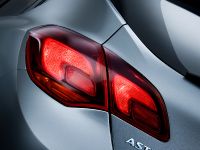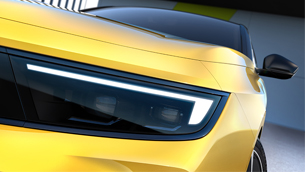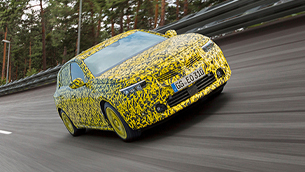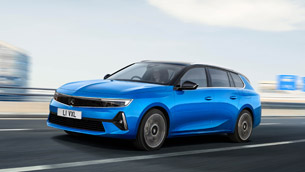The upcoming Vauxhall Astra promise more comfort than ever
The upcoming Vauxhall Astra, which will debut at the Frankfurt Motor Show in September, will not only feature a longer wheelbase and wider tracks for improved stability and ride comfort, but also a cleverly positioned Watts link rear suspension system that is set to offer drivers class-leading handling and ride comfort.
Vauxhall's much-praised FlexRide adaptive damping system will also be available on most Astra models – a feature rarely found in compact class cars.
The new Astra's front and rear tracks have been increased by 56mm and 70mm respectively, while its wheelbase has been increased by 71mm, the cumulative effect being improved handling and ride quality, as well as more space and comfort for occupants.
Continuing Vauxhall's trend for innovation, its engineers have combined the size, weight and efficiency of a compound crank rear axle layout with a cleverly positioned Watts link, which supports lateral forces during cornering.
The FlexRide adaptive damping system, first seen in the European Car of the Year-winning Insignia – adjusts the suspension character automatically depending on drivers' needs, while also offering three programmable damper settings.
Finally, a core body structure, stiffer than that of the outgoing car, enhances the new Astra's ride and handling still further, while also reducing noise and vibration inside the cabin.
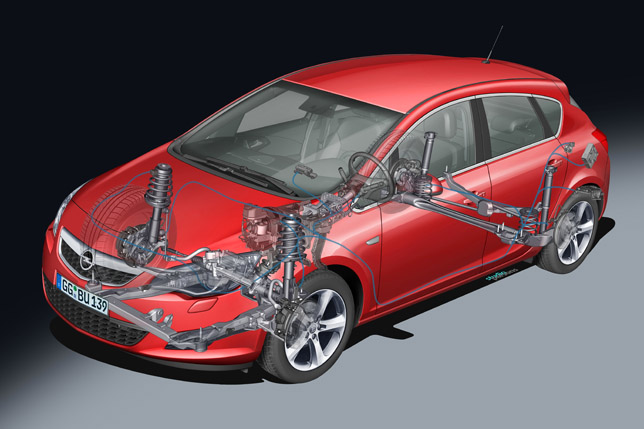
Clever rear axle layout saves space and weight and optimises dynamics
The Astra's new suspension layout combines MacPherson strut front suspension with a clever, newly developed compound crank rear axle with a Watts link. This set-up has many advantages over a multi-link design, including improved packaging, greater wheel camber stiffness and less lower suspension friction. It also creates less camber loss due to body roll, while the Watts link ensures that lateral stability is maintained.
The torsion beam of the compound crank axle is attached between the trailing links, about half way between the axle bush and the rear wheel. The open, U-shaped profile between the attachment points has now been lengthened and the wall thickness generally increased to provide more roll stiffness. In addition, beams with different wall thicknesses are fitted to give the required roll-steer characteristics.
The Watts link is carried on a small cross-member attached to the underside of the car, just behind the rear wheel centre line. It comprises a short, pivoting centre link with a ball joint at each end, to which the lateral links from the wheels are bolted.
In a straight line, the set up ensures excellent stability, but during cornering it minimises lateral deflection in the same way a modern multi-link system would do. In addition, the Watts link reduces axle bush loads to allow softer bushings, which further isolate occupants from road noise and vibration.
The MacPherson struts which feature on the Astra's front suspension incorporate dual-path top mounts that separate spring and damper forces. To reduce unsprung weight and assist weight distribution, the knuckle and the lower control arm are made from aluminium and the anti-roll bar from hollow section steel.
The L-shaped control arm is attached through two bushings to the front subframe. The front bush is particularly stiff to optimise handling, while that at the rear is a radial-loaded hydro-bush. The suspension geometry and the tuning of the bushes are designed to provide both lateral stiffness and longitudinal compliance to benefit ride comfort and handling. The rearmost bush of the L-arm is also hydraulically damped for excellent road isolation, helping to prevent vibration transmission into the car's cabin.
FlexRide system makes welcome return
First seen in the Insignia, and a rarity in this sector, FlexRide offers the driver three settings – Standard, Sport and Tour – while being fully and continually adaptive to changes in driving style and cornering speed.
All four dampers are electronically controlled and continuously adapt within milliseconds to the prevailing road conditions, vehicle movements and individual driving styles, enhancing driver safety.
In addition, FlexRide offers three settings that the driver can programme via dashboard buttons. In Standard mode, FlexRide continuously adapts to all driving conditions, but drivers can also opt for either Tour or Sport settings, too.
Tour mode relaxes the damper settings for a more comfortable ride and also reduces the steering effort, benefiting drivers on long journeys.
Sport mode offers a more connected driving experience: the dampers stiffen; the steering sharpens and the electronic throttle offers a swifter pedal response. To underline this effect, the instrument panel illumination changes from white to red, and if fitted, the Adaptive Forward Lighting system reacts even more quickly. Cars fitted with automatic transmission also have higher up-change points.
As a further refinement, Sport mode includes a customisation menu, where the driver can de-select the damper and steering-assistance elements.
The electronic brain behind FlexRide is the Driving Mode Control module. Using vehicle dynamics information, the DMC constantly monitors driving style and conditions, including acceleration, braking and cornering to optimise the chassis' behaviour.
Apart from a more rewarding driving experience, the FlexRide system offers safety benefits in emergency situations. For an avoidance manoeuvre in Tour mode, for example, chassis sensors convey this information to the DMC and the dampers are stiffened within a millisecond to provide maximum stability.







